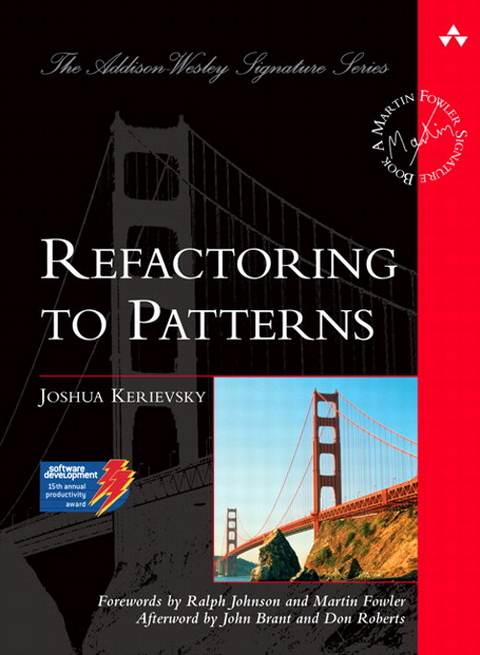
Refactoring to Patterns
Addison-Wesley Educational Publishers Inc (Verlag)
978-0-321-21335-8 (ISBN)
- Titel ist leider vergriffen;
keine Neuauflage - Artikel merken
In 1994, Design Patterns changed the landscape of object-oriented development by introducing classic solutions to recurring design problems. In 1999, Refactoring revolutionized design by introducing an effective process for improving code. With the highly anticipated Refactoring to Patterns, Joshua Kerievsky has changed our approach to design by forever uniting patterns with the evolutionary process of refactoring.
This book introduces the theory and practice of pattern-directed refactorings: sequences of low-level refactorings that allow designers to safely move designs to, towards, or away from pattern implementations. Using code from real-world projects, Kerievsky documents the thinking and steps underlying over two dozen pattern-based design transformations. Along the way he offers insights into pattern differences and how to implement patterns in the simplest possible ways.
Coverage includes:
A catalog of twenty-seven pattern-directed refactorings, featuring real-world code examples
Descriptions of twelve design smells that indicate the need for this book’s refactorings
General information and new insights about patterns and refactoring
Detailed implementation mechanics: how low-level refactorings are combined to implement high-level patterns
Multiple ways to implement the same pattern—and when to use each
Practical ways to get started even if you have little experience with patterns or refactoring
Refactoring to Patterns reflects three years of refinement and the insights of more than sixty software engineering thought leaders in the global patterns, refactoring, and agile development communities. Whether you’re focused on legacy or “greenfield” development, this book will make you a better software designer by helping you learn how to make important design changes safely and effectively.
Joshua Kerievsky is the founder of Industrial Logic (http://industriallogic.com), a company specializing in Extreme Programming. Since 1988, Joshua has been a professional software developer, coach, and instructor for clients such as Bankers Trust, MTV, MBNA, Ansys, MDS Sciex, Nielsen Media Research, and Sun Microsystems. He speaks regularly at conferences, has written numerous articles, and contributed chapters to Extreme Programming Explored (Addison-Wesley, 2001) and Extreme Programming Perspectives (Addison-Wesley, 2002). Joshua lives with his wife and daughters in Berkeley, California.
Foreword by Ralph Johnson.
Foreword by Martin Fowler.
Preface.
What Is This Book About?
What Are the Goals of This Book?
Who Should Read This Book?
What Background Do You Need?
How to Use This Book.
The History of This Book.
Standing on the Shoulders of Giants.
Acknowledgments.
1. Why I Wrote This Book.
Over-Engineering.
The Patterns Panacea.
Under-Engineering.
Test-Driven Development and Continuous Refactoring.
Refactoring and Patterns.
Evolutionary Design.
2. Refactoring.
What Is Refactoring?
What Motivates Us to Refactor?
Many Eyes.
Human-Readable Code.
Keeping It Clean.
Small Steps.
Design Debt.
Evolving a New Architecture.
Composite and Test-Driven Refactorings.
The Benefits of Composite Refactorings.
Refactoring Tools.
3. Patterns.
What Is a Pattern?
Patterns Happy.
There Are Many Ways to Implement a Pattern.
Refactoring to, towards, and away from Patterns.
Do Patterns Make Code More Complex?
Pattern Knowledge.
Up-Front Design with Patterns.
4. Code Smells.
Duplicated Code.
Long Method.
Conditional Complexity.
Primitive Obsession.
Indecent Exposure.
Solution Sprawl.
Alternative Classes with Different Interfaces.
Lazy Class.
Large Class.
Switch Statements.
Combinatorial Explosion.
Oddball Solution.
5. A Catalog of Refactorings to Patterns.
Format of the Refactorings.
Projects Referenced in This Catalog.
A Starting Point.
A Study Sequence.
6. Creation.
Replace Constructors with Creation Methods.
Move Creation Knowledge to Factory.
Encapsulate Classes with Factory.
Introduce Polymorphic Creation with Factory Method.
Encapsulate Composite with Builder.
Inline Singleton.
7. Simplification.
Compose Method.
Replace Conditional Logic with Strategy.
Move Embellishment to Decorator.
Replace State-Altering Conditionals with State 166
Replace Implicit Tree with Composite.
Replace Conditional Dispatcher with Command.
8. Generalization.
Form Template Method.
Extract Composite.
Replace One/Many Distinctions with Composite.
Replace Hard-Coded Notifications with Observer.
Unify Interfaces with Adapter.
Extract Adapter.
Replace Implicit Language with Interpreter.
9. Protection.
Replace Type Code with Class.
Limit Instantiation with Singleton.
10. Accumulation.
Move Accumulation to Collecting Parameter.
Move Accumulation to Visitor.
11. Utilities.
Chain Constructors.
Unify Interfaces.
Extract Parameter.
Afterword by John Brant and Don Roberts.
References.
Index.
| Erscheint lt. Verlag | 26.8.2004 |
|---|---|
| Reihe/Serie | The Addison-Wesley Signature Series |
| Verlagsort | New Jersey |
| Sprache | englisch |
| Maße | 187 x 241 mm |
| Gewicht | 830 g |
| Themenwelt | Mathematik / Informatik ► Informatik ► Datenbanken |
| Informatik ► Software Entwicklung ► Design Patterns | |
| Schlagworte | Softwareentwicklung |
| ISBN-10 | 0-321-21335-1 / 0321213351 |
| ISBN-13 | 978-0-321-21335-8 / 9780321213358 |
| Zustand | Neuware |
| Informationen gemäß Produktsicherheitsverordnung (GPSR) | |
| Haben Sie eine Frage zum Produkt? |
aus dem Bereich


